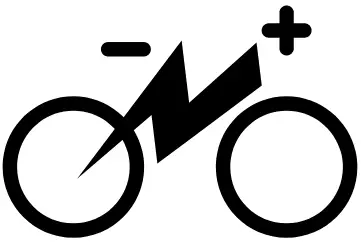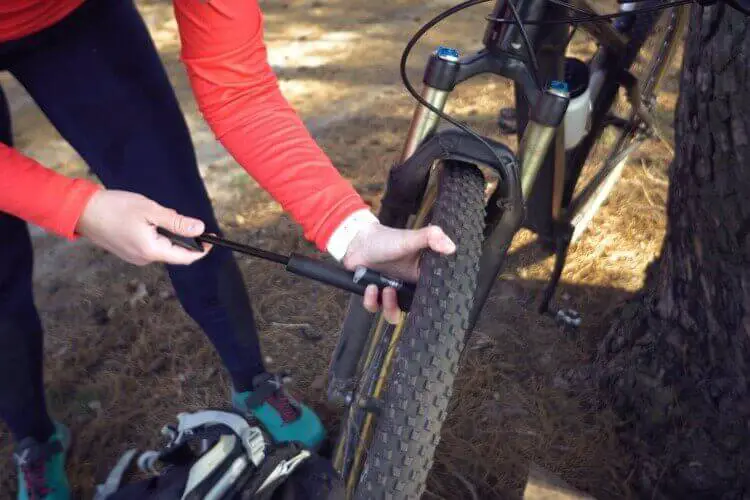If you’re a person who cares about taking care and maintaining your bike, having the right tire pressure for your ebike is important. But when it comes to tire pressure, it’s not one size fits all. You’ll want to have different tire pressures not just for different bikes and tires, but also for different conditions. Let’s take a look…
eBike Tire Pressure Factors
Electric bike tire pressure can get really complicated, but it doesn’t necessarily have to be. Generally speaking, the right pressure will depend on a few things:
- Type of tires
- Type of riding (smooth or offroad)
- Rider weight (including luggage)
The first and easiest place to start is at the tire itself. Though it may be hard to read, the recommended tire pressure will be printed on the side of the tire. You don’t necessarily want to go by the tire pressure for the bike, as models can change and get updated.
However, even within the recommendation, there is a lot of range. So how do you choose?
A good place to start is to understand the benefits of high and low tire pressure.
High vs Low Tire Pressure
In short, higher tire pressure gives you less rolling resistance and makes it easier to carry your speed. Lower tire pressure, on the other hand, gives you more grip and a more comfortable ride.
But it’s not always that simple. Let’s see why…
Higher tire pressure: If you’re on smooth terrain like a paved road, then higher pressure will be better to reduce rolling resistance and give you more speed. On some ultra-skinny wheels, for example, tire pressure can be as high as 120psi!
Most people have a tendency to go with higher pressure than a lower pressure. It’s important to note that the maximum tire pressure listed on the tire is usually too high. It also doesn’t take into account factors like rider weight and different terrain.
Another reason why you might want to consider higher tire pressure is if you are a heavy rider or carrying a lot of gear.
Lower tire pressure: If it’s rainy or you’re off-roading a little bit, then it would be safer to go with a lower number, but still within the recommended range. With lower pressure, the tire will absorb more bumps, giving you a smoother ride. You’ll want a lower pressure especially if you’re during a lot of cornering.
One of the downsides to lower tire pressure is that you’ll probably increase your tire wear. If you ride on low tire pressure for years, you might develop sidewall cracks that could lead to blowouts if you suddenly increase the pressure.
Whichever pressure you choose, one thing that is not recommended (at least until you get more familiar with your tire) is to go outside the manufacture recommendations.
Types of Biking
Another way of looking at tire pressure on your ebike is to look at the type of riding you’ll be doing.
- Road biking – Start with the middle of the recommended range and adjust from there. Most roads are smooth but will still have bumps.
- Mountain biking – Start with a mid range and lower pressure until you get the right balance between grip and comfort.
Pressure can depend on the type and size of the tire. Narrow tires need more pressure. You can expect anywhere from 80-130PSI on a road tire, 25-35psi on a mountain tire, and 40-70psi on hybrid tires.
Front and Back Tire Pressure
Some riders, especially those more experienced, will adjust the front and back tire pressure differently.
As a general rule, you’ll have less pressure in the front tire than the back tire. Especially on ebikes when there can be more weight in the back. If you want optimal grip, experiment with different pressure.
Be sure to check your manual, as your specific ebike might have recommendations for front and back tire pressure. On Rad Power Bikes, for example, the recommended PSI is the same.
Does Rolling Resistance Really Matter?
For those hyper milers and those who want to get every mile they can out of their battery, rolling resistance is going to be something to consider. But, is it really that significant?
Lower tire pressure will indeed help increase rolling resistance, but how effective is rolling resistance when it comes to e-bikes? In most test cases of rolling resistance, tire pressure only accounts for a few watts of power. Take this into account with everything else including wind resistance and gravity, and it’s arguably a small amount. For some, this could still be significant, especially on longer rides.
What does this all mean? That while rolling resistance is a factor, the type of tire you are using is a much bigger factor.
Tire Pressure and Flats
While grip and comfort can be debated, one other consideration not yet discussed is the potential for flats.
As one rider put it:
I’d worry more about flats than “optimal” tire pressure. I have gotten two flats, both when my tire pressure was slightly low. I now always keep my tires, both front and back, at 70 which is between the recommended settings 60-80. It’s hard as heck but offers very little rolling resistance and no flats.
If you are frequently getting flats, one thing you’ll want to look at is your tire pressure. When tire pressure is too low, you run the risk of getting pinch flats. Pinch flats are caused the inner tube getting pinched against the rim, which can be prevented with higher tire pressure.
While you might be able to increase the range of your battery with high tire pressure, you also increase the risk of blowouts.
What about eMBT Tire Pressure?
One of the easiest and cheapest ways to get a better ride is to adjust your tire pressure. Understanding eMBT tire pressure is a little more complicated since there are more variables involved than a “typical” electric bike.
On mountain bikes especially, the ideal tire pressure is going to be a balance between grip and stability.
However, a good starting point is:
- 2.35 -2.5 inch tubeless tire: 1.8 Bar (26 Psi) front and back
- 2.6 – 3.0 inch tubeless tire: 1.4 Bar (20 Psi) front and back
Remember, this is just a starting point and you can adjust accordingly
High pressure will support the sidewalls and offer more protection from the rim. Be careful not to go too high as less tire will make contact with the ground and will make the ride feel harsh.
Low pressure will increase grip and give you a lot of traction. You’ll be able to improve cornering as the softer tire can absorb the terrain. The downside is you run a higher risk of rim damage and you’ll have less spring, which may create an unstable ride at some speeds.
Testing Your Tires
Now that you’ve filled your sites, it’s time to try them out. This is a chance where you can feel how the bike rides and adjust accordingly.
Once you have a baseline tire pressure, you can add or remove pressure as needed. For example, in wet conditions, you might want to remove 10psi to improve traction.
You’ll want to take the bike for a ride where you’ll be riding the most.
Here are some things to check for:
- How bumpy is the ride?
- Is the ride smooth over bumps?
- Do I have enough grip on turns?
- Is the rim being bent?
- Do the front and back tires feel comfortable?
After you come back from your test, you can adjust the tire pressure by 3PSI (0.2 Bar) each time to tweak your ride.
Regular Checkups
Whether you have tube or tubless tires, air will leak out from them over time. A lot of this leakage is due to temperature changes. In fact, it’s estimated that your tire pressure loses 2 percent pressure for every 10F loss in temperature).
So how often should you check your tire pressure? Some riders check before every ride, which is the best practice. But it’s perfectly okay too to check it once a week. If you don’t ride often, then checking it before every ride is preferred.
What’s important when filling your tires is that you use the same pump every time. Each pump is different and it’s a good idea to be consistent. In doing so, you’ll know exactly how much air you need each time.
Conclusion
When it comes to ebike tire pressure, it’s best to follow best practices. When first determining your tire pressure, look at the sidewall to get the manufacture recommendation. This will give you a starting point. It’s usually best to stat in the middle range and adjust from there. If you’re off-roading, lighten up a bit, but not too much as to avoid flats. If you’re on a smoothe surface in dry conditions, then try a higher pressure.


I hate having hard tyres, I prefer softer tyres and have a bit of a bounce to them. I off-road a bit, but I’m talking about just general riding
Hey Sebastian, yeah, softer tyres can make for a smoother ride for sure. Cheers!